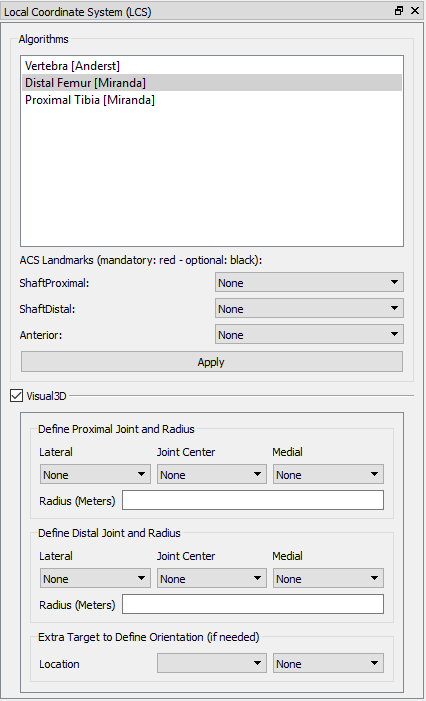This is an old revision of the document!
Table of Contents
Local Coordinate System
An object's local coordinate system (LCS) is the transform from the object's segmented image frame to its local coordinate system (as if you were traveling from the segmented frame to the LCS). This LCS is stored in the subject file and should be defined before tracking in X4D or Locate3D. This is necessary because the tracking output for each X-ray frame is the transformation from the X-ray lab frame to the object's LCS.
Local Coordinate System Widget
Orient3D's Local Coordinate System widget allows users to create an LCS for each object in their data set.
LCS Algorithms
The LCS algorithms are implemented in a dll plugin framework, so it is possible to write your own and plug it into Orient3D. The currently implemented algorithms are:
Vertebra [Anderst]
Anderst, W., personal communication
This algorithm is designed for vertebral disks, and puts the LCS in the middle of the disk with Y pointing superiorly and Z anteriorly. It requires placement of eight landmarks, four around the perimeter of the superior surface of the disk, and four around the perimeter of the inferior surface of the disk.
Distal Femur [Miranda]
Miranda, D., et al. J Biomech 43(8), pp. 1623–26, 2010
This algorithm does not require any landmarks, but supports the use of three optional ones. It is recommended that you first try the algorithm without any landmarks. If the LCS is not calculated properly (which can happen if the femoral shaft is too short), try adding the Anterior landmark, which can go anywhere on the anterior side of the femur. If the LCS is still not right, try adding ShaftProximal and ShaftDistal, which are used to define the long axis of the femoral shaft.
Proximal Tibia [Miranda]
Miranda, D., et al. J Biomech 43(8), pp. 1623–26, 2010
This algorithm does not require any landmarks, but supports the use of three optional ones. It is recommended that you first try the algorithm without any landmarks. If the LCS is not calculated properly (which can happen if the tibial shaft is too short), try adding the Anterior landmark, which can go anywhere on the anterior side of the tibia. If the LCS is still not right, try adding ShaftProximal and ShaftDistal, which are used to define the long axis of the tibial shaft.
Visual3D Panel
The Visual3D panel can be opened by checking its checkbox. This panel allows users to create an LCS using Visual3D's method of defining proximal and distal joints with targets. Consult the Visual3D documentation for details on this method.
Tutorials
There are three methods of defining an LCS, as described in the How To: Define the LCS of an Object tutorial.
See Also
Go back to the Orient3D Overview.

